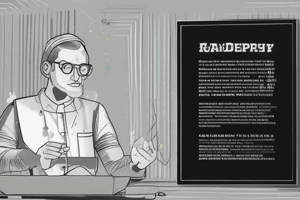Podcast
Questions and Answers
Which principle ensures that data processing only occurs for specified legitimate purposes?
Which principle ensures that data processing only occurs for specified legitimate purposes?
- Integrity and confidentiality
- Data minimisation
- Accuracy
- Purpose limitation (correct)
What does the data minimisation principle mandate?
What does the data minimisation principle mandate?
- Collect data beyond what is necessary for analysis
- Ensure all collected data is accurate and current
- Collect and process only the data necessary for the specified purposes (correct)
- Store data indefinitely until requested for deletion
What is necessary for consent to be valid under GDPR?
What is necessary for consent to be valid under GDPR?
- Consent is valid if given by anyone over 16
- Consent must be specific, informed, and unambiguous (correct)
- Consent can be obtained only through email
- Consent must be implied through actions
Which of the following is NOT a requirement for the integrity and confidentiality of data processing?
Which of the following is NOT a requirement for the integrity and confidentiality of data processing?
What must a data controller demonstrate in relation to GDPR compliance?
What must a data controller demonstrate in relation to GDPR compliance?
What is the primary focus of the lectures based on GDPR?
What is the primary focus of the lectures based on GDPR?
Which of the following constitute the components of GDPR?
Which of the following constitute the components of GDPR?
What is classified as personal data under GDPR?
What is classified as personal data under GDPR?
What role does a data controller have in regards to personal data?
What role does a data controller have in regards to personal data?
Which of the following statements about GDPR is true?
Which of the following statements about GDPR is true?
What is the distinction made in UK law regarding the term 'clauses'?
What is the distinction made in UK law regarding the term 'clauses'?
What is the role of a data processor in the context of GDPR?
What is the role of a data processor in the context of GDPR?
Which of the following is NOT a principle of data processing outlined in GDPR?
Which of the following is NOT a principle of data processing outlined in GDPR?
What is the primary purpose of the GDPR?
What is the primary purpose of the GDPR?
What was a significant change introduced by the Data Protection Act 2018 in relation to GDPR?
What was a significant change introduced by the Data Protection Act 2018 in relation to GDPR?
When was GDPR officially put into effect?
When was GDPR officially put into effect?
What is the expected impact of GDPR on consumer trust?
What is the expected impact of GDPR on consumer trust?
Which of the following is NOT true about GDPR fines?
Which of the following is NOT true about GDPR fines?
What is one of the goals of harmonizing data protection rules across the EU with GDPR?
What is one of the goals of harmonizing data protection rules across the EU with GDPR?
How does GDPR affect businesses operating outside the EU?
How does GDPR affect businesses operating outside the EU?
What is the focus of Chapter III in the GDPR structure?
What is the focus of Chapter III in the GDPR structure?
Which chapter discusses the responsibilities of Controllers and Processors?
Which chapter discusses the responsibilities of Controllers and Processors?
What does Chapter V of the GDPR deal with?
What does Chapter V of the GDPR deal with?
Which chapter contains provisions related to the enforcement and oversight of GDPR compliance?
Which chapter contains provisions related to the enforcement and oversight of GDPR compliance?
Which articles are included in the first set of GDPR articles mentioned in the content?
Which articles are included in the first set of GDPR articles mentioned in the content?
What is a key principle of data processing highlighted in Article 5?
What is a key principle of data processing highlighted in Article 5?
What aspect does Chapter VIII cover regarding GDPR?
What aspect does Chapter VIII cover regarding GDPR?
Which chapter ensures cooperation among member states regarding GDPR implementation?
Which chapter ensures cooperation among member states regarding GDPR implementation?
What is the last chapter in the GDPR structure?
What is the last chapter in the GDPR structure?
What can be inferred about the chapters preceding the final provisions?
What can be inferred about the chapters preceding the final provisions?
Flashcards
GDPR Principles
GDPR Principles
The general principles and requirements that organizations must adhere to when processing personal data.
Articles (GDPR)
Articles (GDPR)
Legal obligations that organizations must follow to demonstrate compliance with GDPR.
Recitals (GDPR)
Recitals (GDPR)
Explanatory information that provides context and justification for the articles.
Personal data
Personal data
Signup and view all the flashcards
Data processing
Data processing
Signup and view all the flashcards
Data subject
Data subject
Signup and view all the flashcards
Data controller
Data controller
Signup and view all the flashcards
Data processor
Data processor
Signup and view all the flashcards
Lawfulness & Fairness
Lawfulness & Fairness
Signup and view all the flashcards
Purpose Limitation
Purpose Limitation
Signup and view all the flashcards
Data Minimization
Data Minimization
Signup and view all the flashcards
Accuracy
Accuracy
Signup and view all the flashcards
Storage Limitation
Storage Limitation
Signup and view all the flashcards
What is the main purpose of the GDPR?
What is the main purpose of the GDPR?
Signup and view all the flashcards
What is the goal of the GDPR in terms of harmonization?
What is the goal of the GDPR in terms of harmonization?
Signup and view all the flashcards
How does the GDPR build trust in the digital economy?
How does the GDPR build trust in the digital economy?
Signup and view all the flashcards
What makes the GDPR unique?
What makes the GDPR unique?
Signup and view all the flashcards
When did the GDPR go into effect, and what happens if you don't comply?
When did the GDPR go into effect, and what happens if you don't comply?
Signup and view all the flashcards
How does the UK handle the GDPR?
How does the UK handle the GDPR?
Signup and view all the flashcards
What are some differences between the GDPR and the DPA2018?
What are some differences between the GDPR and the DPA2018?
Signup and view all the flashcards
How can you understand complex legislation like the GDPR?
How can you understand complex legislation like the GDPR?
Signup and view all the flashcards
What is GDPR?
What is GDPR?
Signup and view all the flashcards
What does Article 1 of GDPR specify?
What does Article 1 of GDPR specify?
Signup and view all the flashcards
What is the purpose of Article 4 in GDPR?
What is the purpose of Article 4 in GDPR?
Signup and view all the flashcards
What types of data processing does Article 2 of GDPR cover?
What types of data processing does Article 2 of GDPR cover?
Signup and view all the flashcards
What principles govern GDPR?
What principles govern GDPR?
Signup and view all the flashcards
What rights do individuals have under GDPR?
What rights do individuals have under GDPR?
Signup and view all the flashcards
Who is the 'Controller' in GDPR?
Who is the 'Controller' in GDPR?
Signup and view all the flashcards
Who is the 'Processor' in GDPR?
Who is the 'Processor' in GDPR?
Signup and view all the flashcards
What are the rules for transferring data outside the EU under GDPR?
What are the rules for transferring data outside the EU under GDPR?
Signup and view all the flashcards
What are Independent Supervisory Authorities (ISAs) in GDPR?
What are Independent Supervisory Authorities (ISAs) in GDPR?
Signup and view all the flashcards
Study Notes
GDPR Overview
- GDPR stands for General Data Protection Regulation
- It is not a set of regulations, but a regulation
- GDPR was introduced to protect individual privacy in the digital age
- It gives individuals more control over their personal data and protects them from unauthorized or unlawful processing
- The legislation creates a single, harmonised set of data protection rules across the EU
- GDPR aims to reduce the risk of data breaches
- It promotes trust in the digital economy by ensuring transparency about how companies collect and use personal data
GDPR's Structure
- GDPR consists of two components: articles and recitals
- Articles are legal requirements organizations must comply with
- Recitals provide additional information, and context to enhance understanding of the articles
- The document is structured in chapters
- The chapters elaborate on various rules and principles governing personal data
GDPR Terminology
- Personal data is any information relating to an identifiable individual
- Data processing is any action taken on data, whether automated or manual
- Data subject is the individual whose data is processed
- Data controller decides how personal data will be processed
- Data processor processes data on behalf of the controller
GDPR Introduction
- GDPR was introduced for multiple reasons:
- To protect the privacy of individuals
- To create a harmonized data protection system within the EU
- To promote trust in the digital economy and discourage data breaches
- GDPR's scope extends to organizations globally, particularly those that target or gather user data from within the EU
GDPR in the UK
- The Data Protection Act 2018 updated UK data protection laws to incorporate GDPR
- GDPR provisions are incorporated into the UK's Data Protection Act 2018, though there may be some variations
Aims of the Lectures
- To understand GDPR, especially the Principles of Data Processing (Article 5) and the Rights of Data Subjects (Article 12)
- To utilize GDPR's structure in answering questions related to computer professions
- To understand how EU regulation (GDPR) has been incorporated into the UK's Data Protection Act 2018
GDPR - Articles 1-4
- Chapter 1: General provisions:
- Article 1: Subject matter and objectives
- Article 2: Material scope
- Article 3: Territorial scope
- Article 4: Definitions
GDPR - Article 1
- This regulation establishes rules for protecting individuals
- It covers personal data processing and free movement of personal data
- It protects fundamental rights and freedoms relating to personal data
GDPR - Article 4
- Defines key terms used in the GDPR, like "personal data" and "processing"
- "Personal data" means any information relating to an identifiable individual
- "Processing" encompasses various operations on personal data (e.g., collection, storage, alteration)
GDPR - Article 2
- This regulation applies to data processing, whether automated or not
- It does not pertain to activities outside the scope of EU law or to member states carrying out activities
- It has exemptions for natural persons/household activities and activities carried out by competent authorities related to public security and criminal law.
GDPR - Article 12
- Transparent information, communication and modalities for exercising data subject rights
- Provide information in a concise, transparent, intelligible form
GDPR - Article 13
— Information to be provided when collecting personal data — Includes details of the controller and data protection officer
GDPR - Article 15
- Right of access to personal information — Includes the purposes of processing, categories of data, recipients of the information, data storage period, and the right to rectification or erasure, restriction of processing
GDPR - Article 16 -22
- Related to rectification and erasure, restriction of processing, right to data portability and rights of object and automated decision making
Studying That Suits You
Use AI to generate personalized quizzes and flashcards to suit your learning preferences.




